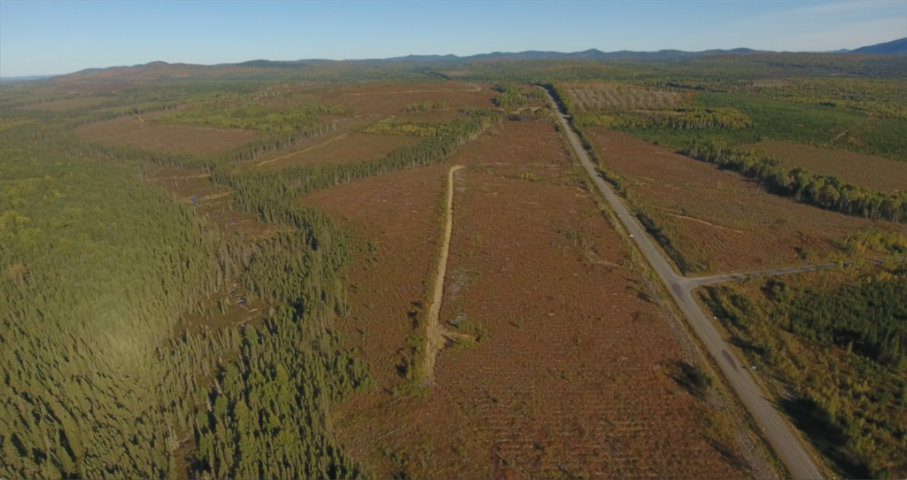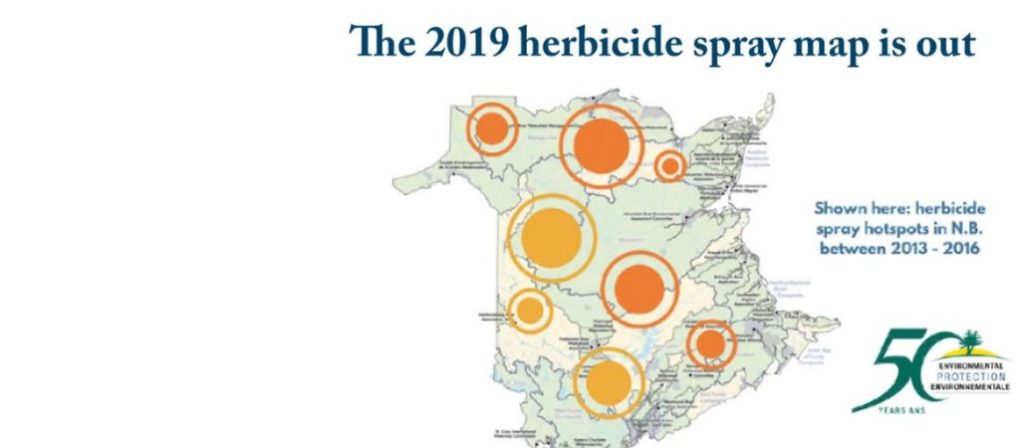[vc_row][vc_column][vc_raw_html]JTNDc2NyaXB0JTIwdHlwZSUzRCUyMnRleHQlMkZqYXZhc2NyaXB0JTIyJTIwc3JjJTNEJTIyJTJGY2NuYi1pbmNsdWRlcyUyRm1sYS1mb3JtLmpzJTIyJTNFJTIwJTNDJTJGc2NyaXB0JTNFJTBBJTNDbGluayUyMHJlbCUzRCUyMnN0eWxlc2hlZXQlMjIlMjB0eXBlJTNEJTIydGV4dCUyRmNzcyUyMiUyMGhyZWYlM0QlMjIlMkZjY25iLWluY2x1ZGVzJTJGbWxhLWZvcm0uY3NzJTIyJTNF[/vc_raw_html][vc_single_image image=”138986″ img_size=”700 x 400″][/vc_column][/vc_row][vc_row][vc_column][vc_column_text]The map showing where the forests will be sprayed with herbicides during summer 2019 is now available.
Forestry companies spray large swaths of clearcuts with products containing glyphosate — a chemical linked to cancer and a slew of other health problems — beginning in August and continued through September.
The full 2019 spray map is available at forestinfo.ca, a partnership between government and the forestry industry. If you want to know if your community, favourite walking trail, or summer swimming hole is near a spray site you’ll have to zoom in on the map until herbicide spray zones appear.
Our team is poring over the map to help New Brunswickers identify the major spraying hotspots this summer. We will update this page with maps of hotspots near lakes, rivers, communities and notable locations in the coming days. Stay tuned![/vc_column_text][vc_single_image image=”136432″ img_size=”large”][/vc_column][/vc_row][vc_row][vc_column][vc_custom_heading text=”Want this old-fashioned and unnecessary practice to stop? Take action today.” font_container=”tag:h3|text_align:center” google_fonts=”font_family:Alegreya%20Sans%3A100%2C100italic%2C300%2C300italic%2Cregular%2Citalic%2C500%2C500italic%2C700%2C700italic%2C800%2C800italic%2C900%2C900italic|font_style:400%20regular%3A400%3Anormal” css=”.vc_custom_1563982008962{margin-bottom: 20px !important;}”][/vc_column][/vc_row][vc_row][vc_column][vc_column_text]Use our letter-writing tool to tell your MLA, the provincial government, and all party leaders to ban the spraying of our forest.[/vc_column_text][/vc_column][/vc_row][vc_row][vc_column width=”1/6″][/vc_column][vc_column width=”2/3″]
The Conservation Council has long advocated that the province stop the old-fashioned, citizen-funded practice of spraying the forest. Quebec banned the spraying of its public forest more than 15 years ago and Nova Scotia stopped using citizens’ money to spray its forest. Glyphosate, the main active ingredient in most herbicides used in Crown forest operations in New Brunswick, was listed as a probable carcinogen by the World Health Organization’s cancer research agency, the International Agency for Research on Cancer (IARC), in 2015. Click here to learn more about glyphosate and its health impacts on people and wildlife.

Conservationists, biologists and hunters are worried that spraying vegetation is wiping out the food and habitats of our forest wildlife. The concern among New Brunswickers is so widespread more than 35,000 people have signed a petition to end the old-fashioned practice, organized by Stop Spraying New Brunswick with support from the Conservation Council. Since 2017, more than 1,800 New Brunswickers have used our letter writing tool to call on their MLA and the provincial government to ban the spraying our forest with herbicides.[/vc_column_text][vc_single_image image=”135444″ img_size=”600″ alignment=”center”][vc_column_text]Let’s take the herbicides out of the woods and put more people to work in 21st century forestry and silviculture practices that conserve and restore a healthy, resilient and diverse forest![/vc_column_text][vc_single_image image=”135745″ img_size=”700 x 300″ alignment=”center”][/vc_column][/vc_row][vc_row][vc_column][vc_custom_heading text=”Help us continue our forest conservation efforts.
Donate today!” font_container=”tag:h3|text_align:center|color:%23000000″ google_fonts=”font_family:Alegreya%20Sans%3A100%2C100italic%2C300%2C300italic%2Cregular%2Citalic%2C500%2C500italic%2C700%2C700italic%2C800%2C800italic%2C900%2C900italic|font_style:400%20regular%3A400%3Anormal” link=”url:https%3A%2F%2Fwww.conservationcouncil.ca%2Fen%2Fabout-us%2Fdonate-to-ccnb%2F||target:%20_blank|”][/vc_column][/vc_row][vc_row][vc_column][vc_column_text]Want to learn more?
- AG report shows DNR ignored calls to reduce clearcutting in public forest
- Dr. Vrain talks longterm health impacts of glyphosate with CBC
- ‘It’s an indication of a corporate agenda’: Conservation Council’s Lois Corbett on Rob Cumberland firing
- Wildlife, forestry and conservation groups join with scientists and academics to call for new Crown Lands and Forests Act
- CCNB statement in response to report released by the Office of the Chief Medical Officer of Health on glyphosate
- The way we manage our forest is outdated: experts
- Cancer classification warrants phase-out of widely-used herbicide
- Canada’s pesticide regulator “captured by industry”
[/vc_column_text][/vc_column][/vc_row][vc_row][vc_column][vc_single_image image=”144070″ img_size=”medium” alignment=”center”][/vc_column][/vc_row]

